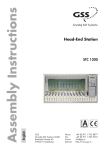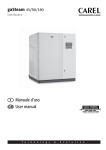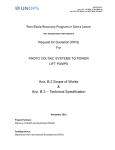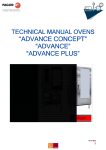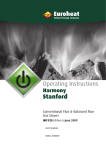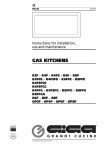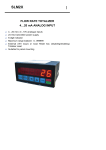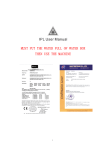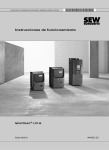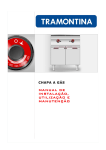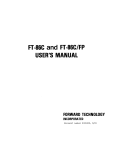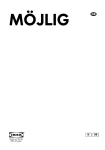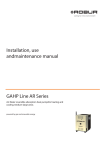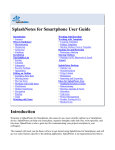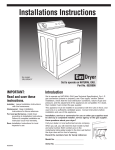Download Gas Hob Manual
Transcript
USER’S MANUAL Please read this instructions carefully before using G4 GAS HOB Content 1. PACKING LIST................................................................................................ 2 2. USAGE PRECAUTIONS................................................................................. 2 3. SAFETY PRECAUTIONS................................................................................ 3 4. PACKAGE DISPOSAL INSTRUCTIONS…………....……………………..........3 5. INSTRUCTIONS FOR THE INSTALLER ....................................................... 4 6. INSTRUCTIONS FOR THE USER................................................................. 12 7. CLEANING AND MAINTENANCE................................................................. 13 8. TROUBLESHOOTING................................................................................... 14 9. ELECTRIC WIRING DIAGRAME AND PARTS NAME DIAGRAM…….........16 THESE INSTRUCTIONS ARE VALID ONLY FOR END USER COUNTRIES WHOSE IDENTIFICATION SYMBOLS(THESE COUNTRIES ABBREVIATION CODE)APPEAR ON THE CARTON LABLE.THE INSTRUCTIONS MUST BE TRANSLATED INTO OFFICIAL LANGUAGE ACCORDING TO THE COUNTRIES OF DESTINATION AND BE VALID IN THESE COUNTRIES. INSTRUCTIONS FOR THE USER: these provide recommendations for use, a description of the controls and the correct procedures for cleaning and maintaining the appliance INSTRUCTIONS FOR THE INSTALLER: these are intended for the qualified engineer who is to install, commission and test the appliance Please pay attention to the amount of accessories, and make sure there is no scarcity or shatters ① Please contact with the dealer when our company or the dealer is responsible for the above carelessness. ② Please contact the nearest service center engaged by special arrangement if the user should bear the responsibility. 1.【Packing List】 1 (1) Built-in gas hob ………………………………….………one (2) Metal circle to fastening rubber tube ………………..one (3) User’s handbook …………………………………….…..one 2.USAGE PRECAUTIONS This manual is an integral part of the appliance. Take good care of it and keep it to hand throughout the hob's life cycle. We urge you to read this manual and all the information it contains carefully before using the appliance. Installation must be carried out by qualified staff in compliance with the relevant regulations. This appliance is intended for household use and complies with the EEC directives currently in force. The appliance is built to provide the following function: cooking and heating foods; all other uses are to be considered improperly. The manufacturer declines all liability for uses other than those stated above. This appliance is not connected to a combustion products evacuation device. It shall be installed and connected in accordance with current installation regulations. Particular attention shall be given to the relevant requirements regarding ventilation. Prior to installation, ensure that the local distribution conditions (nature of the gas and gas pressure) and the adjustment of the appliance are compatible. The appliance belongs to category III that are designed for use with gases of the three families. Never use this appliance for heating rooms. Never use packing residues unattended in the home. Separate the various waste packaging materials by type and consign them to the nearest separate disposal centre. This appliance is marked according to the European directive 2002/96/ec on waste electrical and electronic equipment (WEEE). This guideline is the frame of European-wide validity of return and recycling on waste electrical and electronic equipment. Never obstruct the openings and slits provided for ventilation and heat dispersal. The nameplate with the technical data, serial number and mark are in a 2 visible position underneath the casing. The nameplate must never be removed. 3. SAFETY PRECAUTIONS The appliance is intended for use by adults. Keep children at a safe distance and never allow them to play with it. The appliance becomes very hot during use. Oven gloves should always be worn. Always check that the control knobs are turned to off after each use The manufacturer declines all responsibility for injury or damage caused by failure to comply with the above regulations or deriving from tampering with even just one part of the appliance and the use of non-original spare parts. 4. PACKAGE DISPOSAL INSTRUCTIONS – ENVIRONMENT POLICY Our products are only packaged using non-pollutant, environment-friendly, recyclable materials. We urge you to cooperate by disposing of the packaging properly. Contact your local dealer or the competent local organizations for the addresses of collection, recycling and disposal facilities. Never leave all or part of the packaging lying around. Packaging parts, and especially plastic bags, may represent a suffocation hazard for children. Your old appliance must also be disposed of properly. Important: deliver the appliance to your local organization authorized to collect scrapped appliances. Proper disposal allows the intelligent recovery of valuable materials. Never leave packaging residues unattended in the home. Separate waste packaging materials by type and consign them to the nearest separate disposal centre. The inside of the appliance should be cleaned to remove all 3 manufacturing residues. For further information, see point “CLEANING AND MAINTENANCE”. 5. INSTRUCTIONS FOR THE INSTALLER The following operation requires building and/or carpentry work so must be carried out by a competent tradesman. Installation can be carried out on various materials such as masonry,metal, solid wood or plastic laminated wood , as long as they are heat-resistant(T90℃) 5.1Attachment to support structure,traditional built-in model Create an opening with the dimensions shown in the figure 1 or refer to the table-board cutting template which in the carton. In the work surface, observing a minimum distance of 50mm from the rear edge. This appliance can be installed next to walls that are higher than the work surface, as long as the distance “X” is kept between the appliance and the wall, as shown in the figure, to avoid damage from overheating. Make sure there is a minimum of 750mm between the gas rings and any shelf that may be installed directly above them( figure 2). figure 1 4 figure 2 Put the hob in the right place, then adjust the screw A (figure 3); adjust the screws from (A~C) to the right place (figure 4), make the plate contact tightly with the working top and fix the hob in the plate. figure 3 figure 4 5 5.2 Electrical connection Connection of AC. Make sure that the voltage and capacity of the power supply cable conform to the data shown on the plate located under the protective cover. The power supply cable plug and the wall socket must be of the same type and conform to the current electrical system regulations. Make sure that the power line is adequately earthed. On the power line, install an all-pole disconnect switch with minimum contact gap of 3mm located at an easily accessible position near the appliance. Do not use reducers, adapters or shunts. If the power cable is to be replaced, the wire section on the new cable must not be less than 0.75mm2(3x0.75cable),bearing in mind that the end tube connected to the appliance must have the earth wire (yellow-green)at least 20mm longer. Use only H05V2V2-Fcable or similar which has a maximum temperature of 90℃. Any replacement needed should be carried out by a specialized technician who should make the mains connections according to the following diagram. L=brown N=blue =yellow-green 6 5.3 Gas connection Connection to the gas mains may be made with a rigid copper pipe or with a flexible pipe conforming to the provisions defined by standard regulations in force. After connection operations, make sure there is no leakage through the soapy solution。. If using the G20/G25 natural gas at a pressure of 20/25 mbar,check the leak-tightness ; if using the liquefied petroleum gas (LPG), adjust the reducing valve and increase the normal pressure by 5 mbar, if the pressure can not be adjusted, use the normal gas pressure to check the leak-tightness. 5.3.1 Connection with rigid copper pipe: Connect the gas supply and the product with the metal pipe (show in the figure), put the seal ring B to the surface of the joint C, and screw D to gas pipe A. 5.3.2 Connection with flexible steel pipe: The gas supply should be LPG. The elbow of the appliance and the pressure regulator is fast connectors. Hitch two metal circles E to the two end of the position S. Rotate metal circle E closely to F in order to avoid the flexible tube to be collapsed to make the gas run smoothly , don’t let the flexible pipe be collapsed , drew and crushed . The flexible pipe must be installed so that pipe length does not exceed 2 meters of maximum extension. Make sure that the pipes do not touch any moving parts or become crushed. 7 5.4 Install the flame spread cap: Install the flame spread cap before using the hob. Take the flame spread cap out of the packaging bag, put down the flame cap .To make sure the flame spread cap is the right one, please check the position of the ignition pin D is right below the protector C. 5.5 Connection to LPG Use a pressure regulator and make the connection to the tank according to the provisions of standard regulations in force. Make sure that feed pressure conforms to the levels shown in the table in paragraph “Burner and nozzle data tables” 5.6 Adapting to different types of gas The appliance is tested with G20/G25 (2H) natural gas at the pressure of 20/25 mbar. If it is to be used with other types of gas, the burner nozzles have to be changed and the gas taps adjusted to set the minimum flame. To replace the nozzles, proceed as described below. 5.6.1 Changing the hob nozzles ⑴ Remove the panel, all the burner caps and the flame diffuser rings; ⑵ Use a 7 mm socket wrench to unscrew the burner nozzles; ⑶ Replace the burner nozzles depending on the type of gas to be used (see point “Burner and nozzles data tables” ; ⑷ Put the burners back into place correctly. 8 5.6.2 Burner and nozzle data tables Burner Rated heating capacit y (KW) LPG-G30/G31 28~30/37/50 Mbar Nozzle diameter By-pass Reduce 1/100mm diameter Flow rate Flow rate d flow 1/100 g/h G30 g/h G31 rate (W) 28~30/37 50 mm 276.43 271.38 98 77 65(*) 177 g/h g/h 218.23 214.25 87 72 44(*) 177 g/h g/h Ultra rapid 3.4 burner (1) rapid 3.0 burner(2) Semi-rapi 124.98 d burner 1.75 65 58 34(*) 140 127.3g/h g/h (3) Auxiliary burner 1.0 50 43 29(*) 10 72.74g/h 71.42g/h (4) *:Diameters marked * must be fitted respectively on valves marked * shown inpoint “Regulation of minimum for natural gas”. Natual gas-G20/G25 20/25 mbar Rated heating Nozzle By-pass Burner Reduced flow capacity (KW) diameter diameter rate (W) 1/100mm 1/100 mm Ultra rapid 3.4 135 adjust 177 burner (1) rapid 3.0 122 adjust 177 burner(2) Semi-rapid 1.75 97 adjust 140 burner (3) Auxiliary 1.0 72 adjust 10 burner (4) 5.6.3 Countries of destination for cooking hot plates: Country AT CZ-DK-EE-FI-LT-LV-NO SE-SI-SK-BG-RO-TR CH-ES-GB-GR-IE-IT-PT CY-MT-NL BE-FR DE LU Category II2H3B/P Gas type G20 - G30/G31 Gas pressure(mbar) 20 - 50/50 II2H3B/P G20 - G30/G31 20 - 30/30 II2H3+ I3B/P II2E+3+ II2E3B/P I2E ; I3B/P G20 - G30/G31 G30/G31 G20/G25 - G30/G31 G20 - G30/G31 G20 ; G30/G31 20 - 28-30/37 30/30 20/25 - 28-30/37 20 - 50/50 20 ; 50/50 9 5.7 Final operations for gas appliances After making the adjustment described above, reassemble the appliance, reversing the procedures described in point “Changing the hob nozzles”. After adjusting for use of a gas other than the gas used for testing the appliance, replace the gas setting label inside the warming compartment with the label for the new gas. The label is available from your nearest Authorized Service Centre. 5.7.1 Regulation of minimum for natural gas Light the burner and turn it to the minimum setting. Remove the knob and adjust the regulator screw inside or beside the tap rod (depending on the model) until an even minimum flame is obtained. Put the knob back in place and check the stability of the burner flame (the flame must not go out when the knob is minimum setting). Repeat the operation on all the gas taps. 5.7.2 Regulation of minimum for LPG To regulate the minimum for LPG, fully tighten the screw inside or next to the gas tap pin (depending on the model) in a clockwise direction. The diameters of the by-passes for each burner are given in table “Burner and nozzle characteristics table”. 5.7.3 Lubrication of gas taps With time it may happen that the gas taps get blocked and hard to turn. Clean them inside and re-grease them. This operation must be done by an authorized person. 5.7.4 Greasing the gas taps Over time, the gas taps may become stiff or jam. Clean their insides and change their lubricating grease. The operation must be carried out by a skilled technician. Table 1: Types of connection used in various countries 10 Categories I3B/P, I3+, I3P Without With threads Threads Other categories Push-on With threads connector ISO 7-1 ISO Push-on connector ISO 7-1 ISO228- 1 228-1 Austria yes yes no no yes no no Belgium yes yes yes yes yes no no Denmark yes yes no no yes no no Finland yes yes yes no yes yes no France no no yes no no yes no Germany yes yes no no yes no no Greece yes yes no no yes no no Ireland yes yes no no yes no no Italy yes yes yes yes yes no no Netherlands no yes no yes yes no no Norway yes yes no no no no no Portugal yes yes yes yes yes yes yes Spain no yes yes yes yes yes yes Sweden no yes yes yes yes yes no Switzerland yes yes no yes yes no no United yes yes no no yes no no Iceland ) ) Luxembourg kingdom 1) Taper — taper threads. 2)Taper — parallel threads. 3) Only G 1/2. 4) Except push-on connectors attached with a ISO 228—1 thread. 6. INSTRUCIONS FOR THE USER 11 6.1 Using the hob Before lighting the burners, make sure that the flame -spreader crowns and respective caps are properly fitted In their housings. Ensure the flame-spreader holes A are aligned with the ignition plugs and the thermocouples. The burner it controls is shown next to each knob. The appliance is equipped with an electronic ignition device. Simply press the knob and turn it anti-clockwise to the maximum flame symbol(picture 2), until the burner lights. If it does not light within the first 15 seconds, turn the knob to off (picture 1)and wait at least 60 seconds before trying to light the burner again. On models equipped with valves, once the burner has ignited, keep the knob pressed down for a few seconds to allow the thermocouple to heat up. The burner may go out when the knob is released: in this case, the thermocouple has not heated up sufficiently. Wait a few moments and repeat the operation, keeping the knob pressed down for longer. Once the burner has been ignited, the flame can be regulated as required(picture 3、4 、5). After each use of the hob, always check that the control knobs are turned to off. If the burners should go out accidentally a safety device will be tripped about 20 seconds later, cutting off the gas supply even if the gas tap is open. In this case, turn the knob back to the off position and wait at least 60 seconds before trying to relight the burner. 6.2 Practical hints for using the burners 12 For better burner efficiency and to minimize gas consumption, use pans with flat, even bottoms with lid and of suitable size for the burner, so that flames do not reach up the sides of the pan (see point "5.3 Pan diameters "). Once the contents come to the boil point, lower the flames so that it does not boil over. When cooking, to prevent burns or damage to the hob all pans or griddle plates must be placed inside the perimeter of the hob.Take the greatest care when using fats or oils since they may catch fire if overheated. 6.3 Pan diameters BURNER’s ΦMIN. AND MAX. (IN CM) 1 Ultra Rapid (1) 20-26 2 Assistant (2) 16-24 3 Semi-rapid (3) 12-20 4 Auxiliary 8-16 (4) 7. CLEANING AND MAINTENANCE Never use a jet of steam for cleaning the appliance. 7.1 Cleaning the stainless steel surfaces To keep stainless steel surfaces in good condition, it must be cleaned regularly, after each use of the appliance, first allowing it to cool. 7.1.1 Routine daily cleaning When cleaning and caring for stainless steel surfaces, always use only specific products which do not contain abrasives or chlorine-based acids. Instructions for use: pour the product onto a damp cloth and wipe over the surface, then rinse thoroughly and dry with a soft cloth or chamois leather. 7.1.2 Food stains or spills Never use metal scouring pads or sharp scrapers which will damage the surface. Use ordinary non-abrasive products for steel, with the aid of wooden or plastic utensils if necessary. Rinse thoroughly and dry with a soft cloth or chamois leather. 7.2 Cleaning of cooking hob components To facilitate cleaning, pan stand grids, caps, flame spreader crowns and burners are all removable; wash with warm water and non-abrasive detergent, taking care 13 to remove all stubborn food residues. Wait for all parts to be fully dry before remounting. Refit the caps on the respective flame-spreader crowns, making sure that notches A align with burner pins B. To work well, the ignition plugs and thermocouples must always be very clean. Check them frequently and clean them with a wet cloth if necessary. Any dry residue should be removed with a toothpick or a needle. 8. TROUBLESHOOTING Problems The cause of problem It is forgotten to open the general gas valve Air is mixed into the gas pipe The rubber tube bends or flattens Ignition device and insulation point is dirty an damp Settlements for the problems Firstly turn off the knob, and then open the general gas valve Ignite repeatedly until the air is absolutely discharged Unfold or change the rubber tube Clean it with a dried cloth Safety valve doesn’t open Press an turn the knob to intense fire, make sure the hob is fired and keep on pressing for 3 to 4 seconds The battery is out of use; the battery doesn’t touch well; or the battery is up side down Change the battery or refix the battery There’s problem with the ignition device or the ignition pin is not in the right position Ask the professional maintenance man for maintaining It won’t fire 14 There is a warning tone when ignition Gas leak Unstable flame Soft and yellow flame The flame escapes from the dire hole or flameout is with fulmination Few flames The flame isn’t in uniform length and the flame is yellow The flame accidentally goes red The battery is low Change the battery The rubber tube cracks or Change the rubber tube breaks The rubber tube joint doesn’t Check the air-tightness of the connect well with rubber gas tube and set it properly tube or other tube Change into a new bottle of Whether the LPG is used up LPG The throttle is not properly Gradually enlarge the throttle adjusted, and the air is until the flame turns normal insufficient blue The throttle is not properly adjusted, and the air is insufficient Gradually enlarge the throttle until the flame turns normal blue Injector or stopcock is jammed Fire lid is not properly covered, and there’ s charcoal other dirt stuffing the fire hole Use a iron wire to dredge the injector or the valve core Under a certain climate, the gas is with much humidity Make sure that the fire lid is on the right position ; get rid of the dirt in the fire hole The flame turns red because there’s calcium in water, so don’t be worry about it 9. ELECTRIC WIRING DIAGRAME AND PARTS NAME DIAGRAM 【Electric Wiring Diagram】 4-burner hob 15 5-burner hob 16


















